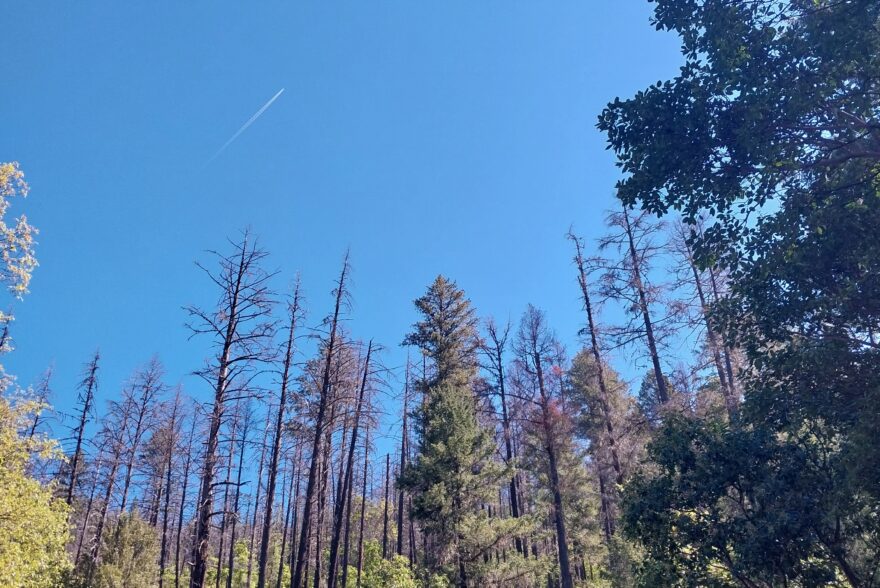Douglas fir decline spiral: Threats, implications, and opportunities for proactive management


In May 2024, I had the opportunity to join the Oregon Chapter of the Society of American Foresters’ annual conference in Ashland, Oregon. The highlight was spending a day in the field learning about one of the most pressing issues for southern Oregon forests: the Douglas fir decline spiral or “Firmageddon.”
Written by: Kelsee Taylor, Project Development Manager
In May 2024, I had the opportunity to join the Oregon Chapter of the Society of American Foresters’ annual conference in Ashland, Oregon. The highlight was spending a day in the field learning about one of the most pressing issues for southern Oregon forests: the Douglas fir decline spiral or “Firmageddon.” We learned from researchers, foresters, tree pathologists, and entomologists what might be causing this mass tree mortality event and what actions local experts are taking to conserve and restore healthy tree stands.
Southern Oregon has been an epicenter for this decline in the Pacific Northwest. However, many areas spanning from the Southwestern U.S. to British Columbia have experienced a significant increase in Douglas fir mortality in recent years. “Based on aerial survey data, more trees died in the four-year period from 2015 to 2019 than in the previous four decades.” (Bennett, M. and Adlam, C. 2023). As conditions worsen we are seeing 100 years of forest growth die within one year, a pattern that is unsustainable for our forests. Not only are we losing hundreds of thousands of trees each year, but the trees that remain have shown a significant decrease in growth patterns. Smaller, less vigorous trees can be more susceptible to future mortality from these climatic events.
No one factor is causing this decline spiral. Instead, it is the result of numerous stressors caused by our changing climate. Some of the leading causes have been attributed to decades-long wildfire suppression in an area that has historically seen frequent low-severity fires which created a mosaic of healthy diverse forest stands. Without these frequent fires, forest stands have become less diverse and consequently less resilient to stressors like drought or disease. The two most significant factors include multi-year droughts and record-breaking temperatures that continue to increase every year. These conditions have stressed the trees, leaving them especially vulnerable to pests and disease. The flat-headed fir borer has proliferated to unsustainable populations throughout the region. These native insects typically feed on dead and dying trees at a manageable rate, but have begun moving onto relatively vigorous trees due to the Douglas firs being under extreme stress. Drought conditions also decrease water availability, causing arbor embolism. As trees struggle to pull water from the dry soil to their leaves they can instead pull air into their xylem—the cells in their trunks which carry water to the canopy—which leads to impaired conductivity, increasing a tree’s mortality risk.
Douglas fir is an ecologically and economically important species in the Pacific Northwest region. Impacts and future implications of this decline include many risks to forest health and communities alike. The relatively large and vigorous stands that are now dying leave significant areas of dead standing trees, impacting the safety of recreation and travel. Large amounts of dead trees and increases fuel loads, which sets the stage for more extreme wildfires, creating additional risk to communities and wildland firefighters. These dying forests are becoming less desirable habitats for wildlife and have reduced carbon storage capacity. Importantly, Douglas fir is one of the most desirable trees for wood products, so high mortality rates contribute to more challenges in a struggling industry. What were once managed logging operations are quickly turning to salvage logging efforts straining the already limited infrastructure for processing these trees within the limited time frame that they are still economically viable.
How can proactive management help reduce the spread and protect healthy trees? All of these conditions are overwhelming and on a scale that will be an immense ongoing management challenge. While we cannot negate the effects of global climate change, we can give our forests a fighting chance through adaptive land management practices that include: thinning stands that have a lower mortality risk; promoting more drought tolerant species in drier hotter areas like pine, oak, and incense cedar; removing dead and dying stands—especially those that pose the highest risk to communities, like in forested lands surrounding the city of Ashland; returning the landscape to a healthy fire regime; and managing for Douglas fir in areas that are cooler and wetter, such as north-facing slopes.
The U.S. Forest Service, Bureau of Land Management, and the City of Ashland in partnership with Lomakatsi Restoration Project have adopted proactive management approaches and have begun salvage logging operations that can help to remove the dead and dying trees. A compounding issue is that several mills in Oregon have closed—6 in the last 2 weeks—so there is limited capacity to process the immense amount of material coming off of these projects. Without the revenue that would be created by processing this material, less funding is available for restoration work. If the trees can’t pay their way off the forest, fewer acres will be treated.
Thinning and prescribed fire projects are planned throughout the region, and in active management areas such as Pilot Joe the Douglas firs are notably healthier than in other places in the Applegate Valley. Strategically returning healthy fire regimes to the region, reducing density, creating open patches or mosaics within stands, and promoting tree species diversity have proven to be effective tools across many regions to not only promote healthier forests but also protect communities from the continued threat of catastrophic wildfires.
Bennett, M. and Adlam, C. (2023) Trees on the Edge: Understanding Douglas-fir Decline and Mortality in Southwest Oregon